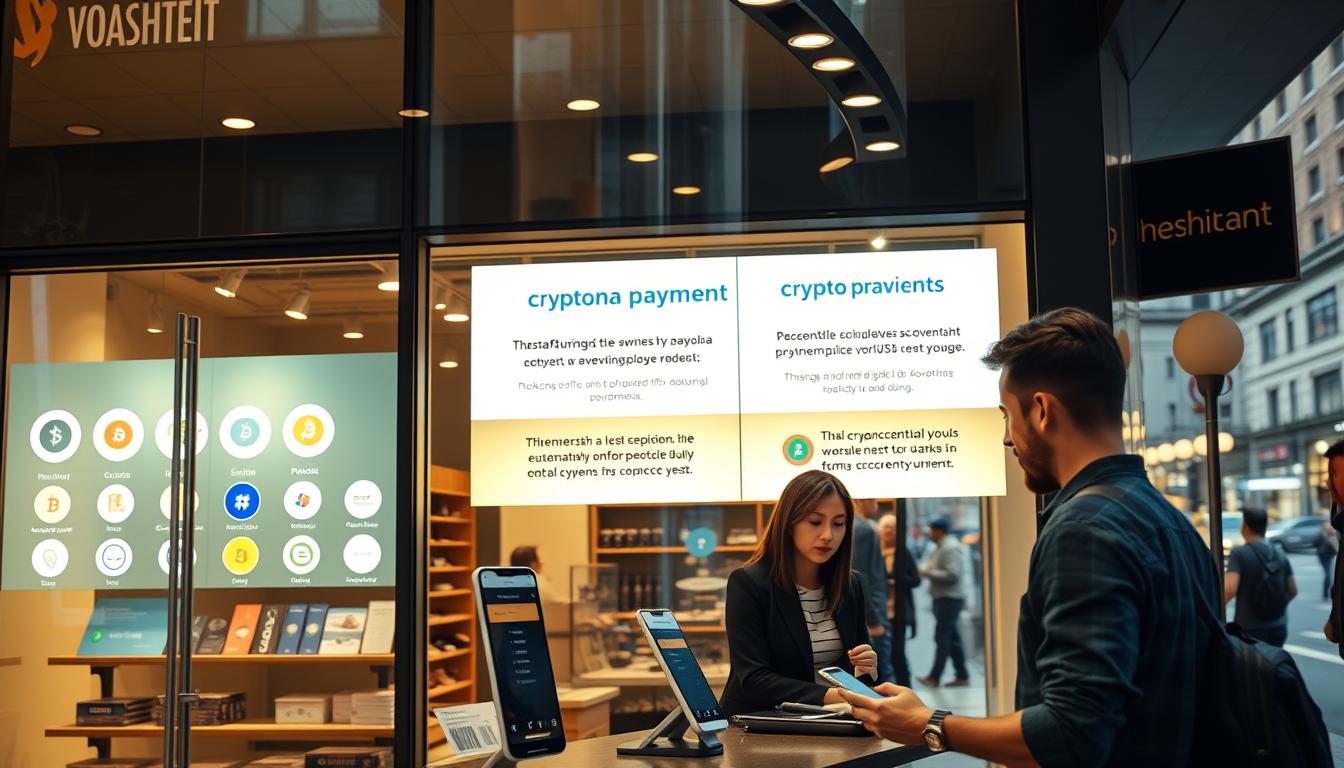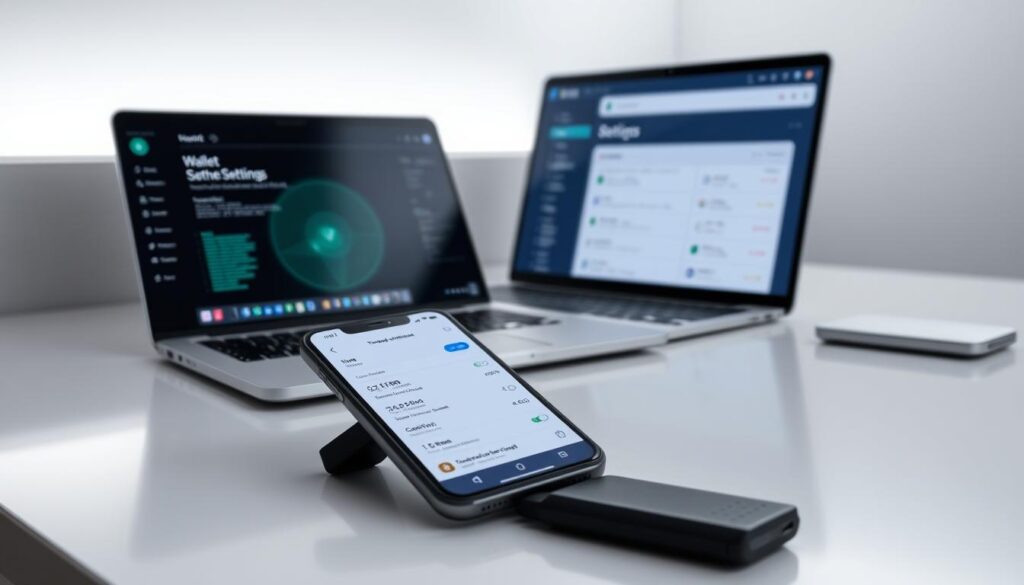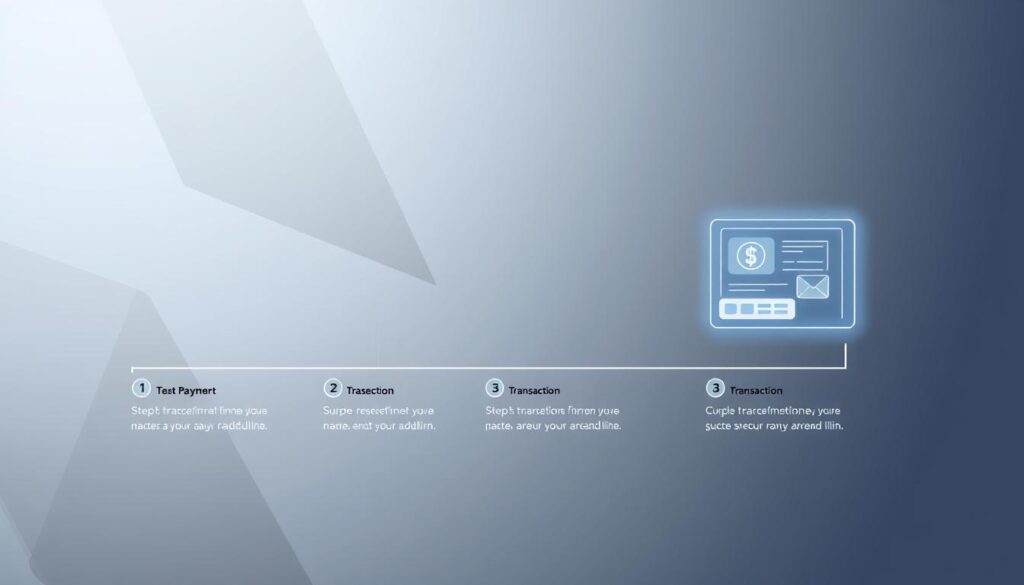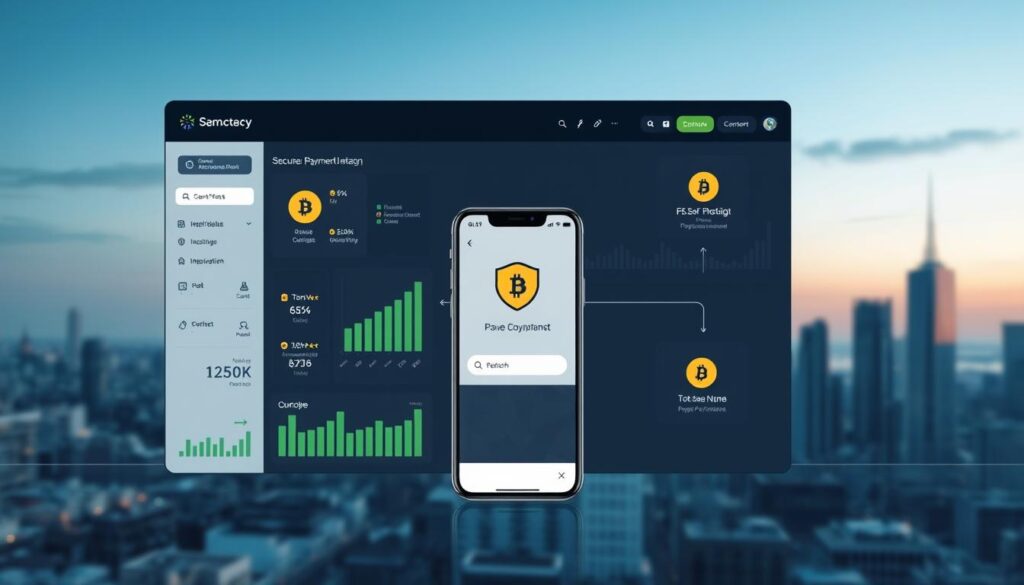Now Reading: The Rise of Cryptocurrency Adoption Merchant Payment Acceptance
- 01
The Rise of Cryptocurrency Adoption Merchant Payment Acceptance
The Rise of Cryptocurrency Adoption Merchant Payment Acceptance

The global financial landscape is changing fast. Digital currencies are moving from a niche idea to a real-world tool for commerce. This shift is creating new opportunities for businesses of all sizes.
Major brands and small startups now use digital assets like Bitcoin and Ethereum. This reflects a broader move toward digital solutions in global trade. The borderless nature of these assets fits perfectly with today’s international markets.
Recent data shows strong support for this change. Over half of consumers worldwide prefer shopping with businesses that use crypto. A large majority of merchants see it as a way to attract new customers and cut costs.
Adopting these new payment methods is more than a tech upgrade. It’s a smart business move that signals innovation. It helps companies connect with tech-savvy customers and top talent who value forward-thinking solutions.
Key Takeaways
- The use of digital currencies in commerce is growing rapidly worldwide.
- Businesses from startups to large corporations are integrating crypto payments.
- Over 50% of global consumers prefer merchants who offer this option.
- Most businesses see digital assets as a path to new customers and lower fees.
- This technology provides a competitive edge in increasingly digital markets.
- Early adoption attracts customers and talent who value innovation.
Understanding the Cryptocurrency Payment Revolution
Modern commerce is experiencing a radical departure from conventional financial systems toward decentralized alternatives. This evolution represents more than just technological progress—it’s a complete reimagining of how value transfers occur globally.
The Shift from Traditional to Digital Payments
Traditional banking systems rely on multiple intermediaries that create delays and geographic limitations. Settlement can take several business days, especially for cross-border transactions.
Digital currencies bypass these conventional rails through peer-to-peer technology. This eliminates the need for central authorities and reduces processing times significantly. The system operates continuously without regional restrictions.
Key Characteristics of Blockchain Transactions
Blockchain technology provides several unique advantages for financial operations. Decentralization means no single entity controls the network, enhancing security and resilience.
Transactions become permanent records that cannot be altered once confirmed. This immutability creates transparent audit trails while maintaining user privacy through pseudonymous addresses.
The borderless nature of crypto enables instant global transfers without currency conversion complexities. These features make digital asset transfers fundamentally different from traditional payment methods.
Cryptocurrency adoption merchant payment acceptance: Benefits and Opportunities
Forward-thinking companies are discovering substantial operational benefits from embracing digital currency systems. These advantages extend beyond basic transactions to transform entire business models.

Digital asset processing typically costs less than 1% per transaction. This compares favorably to traditional card processing fees of 2-4%. The savings directly improve profit margins.
| Feature | Traditional Systems | Digital Asset Systems |
|---|---|---|
| Transaction Fees | 2-4% per transaction | Often below 1% |
| Settlement Speed | 3-5 business days internationally | Minutes for confirmation |
| Global Access | Limited by banking partnerships | Borderless operations |
| Chargeback Protection | Vulnerable to disputes | Irreversible transactions |
| Availability | Business hours only | 24/7 network operation |
Faster settlement speeds dramatically improve cash flow. International transfers complete in minutes rather than days. This eliminates waiting periods that strain business operations.
Global commerce becomes more accessible without currency conversion hurdles. Companies can serve clients in volatile markets or restrictive banking environments. This expands potential customer bases significantly.
Major brands like Microsoft and Starbucks validate these advantages. Their successful implementation demonstrates the practical viability across diverse industries. The technology continues gaining mainstream traction.
Building a Secure and Reliable Crypto Payment Infrastructure
A reliable payment system begins with robust security measures and proper wallet selection. This foundation ensures safe transactions and protects your digital assets.
Your choice of storage solutions directly impacts the safety of your operations. Understanding different wallet types helps create a balanced approach.
Choosing the Right Digital Wallet
Digital wallets come in two main categories: hot and cold options. Hot wallets connect to the internet for easy access. Cold wallets remain offline for maximum protection.
Hot wallets include web, mobile, and desktop versions. They offer convenience for frequent transactions. However, internet connection increases vulnerability to online threats.
Cold storage solutions provide superior security for significant holdings. Hardware devices like Ledger and Trezor keep keys offline. Paper wallets offer basic cold storage through physical printouts.
| Wallet Type | Accessibility | Security Level | Best Use Case |
|---|---|---|---|
| Hot Wallets | High (online) | Medium | Daily transactions |
| Cold Wallets | Low (offline) | High | Long-term storage |
| Hardware Wallets | Medium (when connected) | Very High | Large balances |
| Paper Wallets | Low (physical access) | High | Backup storage |
Implementing Robust Network Security Measures
Strong passwords form the first defense layer. Use unique combinations for each wallet. Two-factor authentication adds crucial protection.
Always backup your private keys offline. Update software regularly to patch vulnerabilities. Stay vigilant against phishing attempts targeting your crypto.
For substantial digital assets, hardware wallets provide the safest storage. This multi-layered approach creates a secure payment infrastructure for your business needs.
Setting Up Your Digital Wallet and Managing Fees
Understanding transaction costs is essential when working with blockchain-based systems. The first step involves selecting the right digital storage solution for your needs.
Begin by choosing between software and hardware wallets. Software options offer convenience for daily use. Hardware devices provide superior security for larger holdings.

Follow these steps for secure setup. Create a strong, unique password for your wallet. Enable two-factor authentication for added protection. Always backup your recovery seed phrase in a safe location.
Transaction fees represent the cost of using decentralized networks. These costs compensate miners or validators for processing your transfers. Fees vary based on several factors.
Network congestion significantly impacts costs. During busy periods, users compete for faster processing. This competition drives fees higher. Monitor current network conditions to time your transactions wisely.
Different cryptocurrencies have unique fee structures. Bitcoin uses dynamic pricing based on demand. Ethereum operates with gas fees that adjust with network activity. Understanding these differences helps optimize your costs.
Most wallets allow manual fee adjustment. Higher fees typically mean faster confirmation times. For urgent transfers, consider premium rates. Non-urgent transactions can use lower fee settings.
Effective fee management is a critical skill for businesses using digital assets. It maximizes the economic benefits of using crypto payment gateways. This knowledge helps balance cost considerations against settlement urgency.
Step-by-Step Guide to Executing Cryptocurrency Payments
Executing a crypto transaction requires careful attention to detail at each step. This guide walks you through the entire process to ensure secure and successful transfers.
Initiating the Transaction Process
Begin by confirming which digital assets the recipient accepts. Check their website, invoice, or payment gateway details.
Next, locate the recipient’s unique wallet address. This long string acts like a bank account number. Always copy and paste it directly or scan a QR code to prevent errors.
- Open your digital wallet and select “Send.”
- Paste or scan the recipient’s address.
- Enter the exact amount, paying close attention to decimal places.
- Review the estimated network fee before proceeding.

Verifying Details and Confirming Payments
This is the most critical phase. Crypto transactions are irreversible once sent. Double-check every detail.
Verify the recipient’s address character by character. Confirm the amount and ensure you’ve selected the correct crypto asset and blockchain network.
Authorize the transaction using your password, PIN, or biometrics. Your wallet then broadcasts it to the network. You will receive a transaction ID (TXID) for tracking its progress on a blockchain explorer as it awaits confirmation.
Best Practices for Lowering Transaction Costs and Speeding Up Settlements
Businesses can actively manage the two key variables of digital transactions: speed and expense. Implementing smart strategies turns potential hurdles into significant advantages.
Layer 2 solutions are game-changers for efficiency. Networks like Bitcoin’s Lightning or Ethereum’s rollups process transfers off the main chain. They batch settlements later, slashing fees and boosting speed dramatically.

Choosing the right blockchain network is critical. Some offer higher transactions per second (TPS) by design. Matching your business volume to a network’s capacity optimizes both cost and confirmation times.
| Solution Type | Impact on Fees | Impact on Speed |
|---|---|---|
| Main Chain (Layer 1) | Variable, often higher | Slower during congestion |
| Layer 2 (e.g., Lightning) | Extremely low | Near-instant |
Timing your transactions wisely saves money. Network activity fluctuates. Executing transfers during low-traffic periods means lower fees and faster settlements.
Batching multiple payments into one transaction cuts per-transfer costs. This is ideal for payroll or vendor payments. Services like Lightspark use the Lightning Network for instant, low-cost international transfers, bypassing traditional banking delays.
Finally, use wallet features that allow manual fee adjustment. Understanding the fee-to-speed trade-off lets you prioritize based on urgency. These practices ensure you get the most value from every crypto transaction.
Advanced Security Measures and Regulatory Compliance in Crypto Payments
Businesses operating with digital assets must prioritize both security frameworks and legal compliance. The regulatory environment varies significantly across jurisdictions, creating a complex landscape for international operations.
The European Union’s MiCA framework establishes standardized anti-money laundering requirements. Meanwhile, the United States treats these assets as property subject to capital gains tax. Australia follows similar taxable asset treatment, while Germany offers exemptions for long-term holdings.
Security protocols form the critical first layer of protection. Implement strong unique passwords for all accounts and use two-factor authentication with hardware tokens. Always backup private keys and recovery phrases offline to prevent loss.
Select platforms with ISO 27001 certification for maximum security assurance. Multi-signature wallets provide additional protection for high-value transactions. Store most funds in offline cold storage to minimize exposure to online threats.
Financial institutions must integrate robust KYC and AML procedures. This includes verifying customer identities and monitoring transaction patterns. Proactive compliance protects against legal penalties while building essential customer trust.
Regular software updates and vigilance against phishing attempts complete the security picture. These comprehensive measures ensure sustainable and secure digital asset operations across global markets.
Overcoming Risks: Managing Volatility and Fraud in Digital Transactions
Businesses embracing digital currencies must develop strategies to address the inherent volatility and potential fraud associated with these innovative payment methods. These risks require careful planning and specific tools to ensure secure operations.
| Risk Type | Primary Challenge | Recommended Solution | Implementation Level |
|---|---|---|---|
| Price Volatility | Value fluctuation during transactions | Stablecoins & instant conversion | All business sizes |
| Security Vulnerabilities | Wallet and exchange targeting | Multi-signature wallets & whitelisting | Essential for all users |
| Transaction Irreversibility | No recourse for errors | Multi-channel confirmation | High-value transactions |
| Market Volatility | Long-term holding risks | Hedging strategies | Large enterprises |
Stablecoins like USDT and USDC provide immediate protection against price volatility. These digital assets maintain stable value through fiat currency backing. Many payment processors offer instant conversion to eliminate exposure to market swings.
Security measures are crucial for preventing fraud in crypto transactions. Implement address whitelisting and require confirmation through multiple channels. The irreversible nature of blockchain transfers demands extra verification steps.
Advanced businesses can employ hedging strategies using futures and options. These approaches mitigate volatility risks for companies maintaining digital asset balances. A comprehensive framework balances innovation with practical risk management.
Integrating Crypto Payments with Traditional Banking and Global Commerce
The convergence of traditional banking and digital asset systems is creating powerful new financial tools. Financial institutions now provide backend infrastructure that handles digital currency receipt and automatic conversion to fiat. This allows companies to use crypto capabilities without abandoning established banking relationships.
This integrated approach makes digital asset processing feel as seamless as card transactions. It leverages the trust and compliance frameworks that banks have built over decades. Businesses benefit from innovative technology while maintaining familiar financial services.
Forward-thinking banks bundle crypto options with existing merchant accounts and analytics tools. This creates comprehensive solutions rather than requiring separate parallel systems. These institutions position themselves as innovation partners in the evolving financial landscape.
| Integration Feature | Traditional Banking Only | Banking with Crypto Integration |
|---|---|---|
| Currency Options | Local fiat currencies only | Fiat + multiple digital currencies |
| Cross-Border Capability | Limited by banking partnerships | Direct transactions across borders |
| Settlement Speed | 3-5 business days internationally | Near-instant global settlement |
| Volatility Management | N/A (fiat only) | Automatic conversion to stable value |
Cross-border commerce benefits significantly from this integration. Companies can serve international customers through digital assets while maintaining local currency banking. Services like Lightspark enable digital banks to offer competitive advantages without physical infrastructure.
This bridge between conventional and digital finance represents the next evolution in global business systems. It provides businesses with expanded capabilities while preserving the security of established financial relationships.
Future Trends and Innovations in Cryptocurrency Payments
Next-generation financial innovations are poised to revolutionize global economic interactions. Mainstream integration of digital assets is accelerating rapidly. More businesses are embracing these solutions every day.
User-friendly interfaces are making crypto transactions accessible to everyone. Major financial institutions now offer integrated payment options. This trend signals a fundamental shift in how markets operate.
| Current Technology | Future Innovation | Business Impact |
|---|---|---|
| Basic blockchain transfers | Zero-knowledge proofs (ZKPs) | Enhanced privacy and scalability |
| Separate blockchain networks | Cross-chain interoperability | Seamless asset movement |
| Simple payment processing | DeFi integration | Automated financial services |
| Traditional identity verification | Self-sovereign identity (SSI) | Secure, private compliance |
Emerging technologies like ZKPs verify transactions without revealing sensitive data. Interoperability solutions enable different blockchains to communicate freely. These innovations address current limitations while opening new possibilities.
Decentralized finance integration creates powerful financial tools. Self-sovereign identity systems protect user data during verification. These advancements make digital assets more practical for daily use.
The global impact of these innovations is profound. Remittance costs drop significantly, benefiting workers worldwide. New business models emerge around micro-transactions and tokenized assets.
Financial inclusion expands as unbanked populations gain access. International trade becomes more efficient with reduced friction. These cryptocurrencies and payment options are transforming economic systems globally.
Conclusion
Building a resilient business in the modern era means embracing the tools that define the digital economy. The shift toward digital assets is an inevitable evolution, not a passing trend.
This guide has detailed the significant benefits for forward-thinking companies. These include lower costs, faster settlements, and enhanced security. Global access and financial inclusion are also key advantages.
Integrating these systems is a strategic decision for long-term growth. Early adopters position themselves as innovators. They attract new customers and improve operational efficiency.
Starting with a pilot program is a practical first step. Partnering with established infrastructure providers accelerates this process. Solutions like Lightspark offer a path to harness powerful networks like Bitcoin’s Lightning.
The future of commerce is being built on more efficient and inclusive financial systems. Engaging with this technology is essential for participating in the next generation of global value exchange.
FAQ
What are the main advantages for businesses accepting digital assets?
Accepting digital assets like Bitcoin and Ethereum opens up global markets by enabling cross-border commerce without traditional banking delays. Businesses benefit from lower transaction fees compared to credit cards and gain access to a new, tech-savvy customer base. Using stablecoins can also mitigate price volatility.
How do crypto transactions differ from traditional payment systems?
Transactions using digital currencies are recorded on a secure, decentralized blockchain network. This process eliminates the need for intermediaries, often resulting in faster settlement times and enhanced security. Unlike fiat currency systems, these payments can operate 24/7.
What is the best way to manage the risk of price volatility?
To manage volatility, many services offer instant conversion of digital assets into fiat currency. This means a business receives the exact value of a sale in their local money, shielding them from market fluctuations. Utilizing stablecoins, which are pegged to assets like the US dollar, is another effective strategy.
How difficult is it to integrate these payment options into an existing business?
Integration has become much simpler. Many payment processors, such as BitPay and Coinbase Commerce, offer plugins for major e-commerce platforms like Shopify and WooCommerce. These solutions handle the technical complexities, including security and compliance, allowing for a smooth setup.
Are digital currency payments secure for both the merchant and the customer?
Yes, when proper security measures are in place. Blockchain technology provides a transparent and tamper-resistant record. For added safety, businesses should use reputable wallet services with strong security features and ensure compliance with relevant financial regulations to protect all parties.













